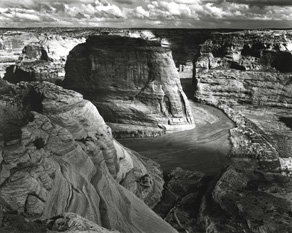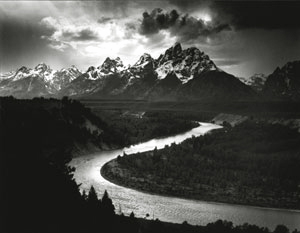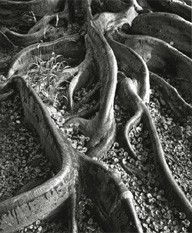Ansel Adams Celebration of Genius
Ansel Adams Celebration of Genius
In December of 1955, Vincent Hartgen, the founding director of the museum had the prescient vision to organize an exhibition of Ansel Adams photographs. The Museum of Art was the first institution in Maine to exhibit Ansel Adams, long before he gained the reputation his work enjoys today. Fifty years later, the exhibition Ansel Adams: Celebration of Genius was presented at the University of Maine Museum of Art from July 15 through October 8, 2005. The exhibition consisted of over 100 works, including Adams lush early photographs of Yosemite, many of his most famous images, portraits, still lifes, and abstracts, as well as a portfolio of rarely seen parmelian prints.
Ansel Adams (1902-1984), is among the few photographers in the history of photography whose name and work enjoys world-wide recognition. His stunning landscapes and intimate still lifes of nature continue to enthrall viewers. Many come to know his work through widely published books, postcards, posters and calendars. Relatively few have actually seen his exquisitely-printed images in the original. To do so is to see the genius in both his craft of printing and his artful composition. Adams is a master. Ansel Adams: A Celebration of Genius honored the man and celebrated that genius.
Adams has long been recognized as one of America’s premier photographers. Born in 1902, he grew up in San Francisco and was introduced to the expanse of California’s Yosemite Valley while on a family vacation at the age of fourteen. At this time he was given a No. 1 Brownie Box camera. These two events strongly influenced the course of Adams’s life. Fascinated by photography and impressed with the beauty of the Sierra mountains, Adams worked with a photofinisher in San Francisco during the winter and returned to Yosemite every summer.
As a teenager, Adams worked towards becoming a concert pianist, but by 1930, after viewing negatives made by east coast photographer Paul Strand, he chose instead a career in photography. His decision to become a full-time photographer contributed to the formation of a new vision in photography in the West. Adams, along with other California Bay Area photographers such as Edward Weston, Imogen Cunningham, Sonya Noskowiak, Henry Swift, and John Paul Edwards, founded Group f/64 in protest to the sentimental and imitative style prevalent in the long-standing, turn-of-the-century, photographic trend of pictorialism. The name f/64 refers to the smallest lens opening on the camera through which light passes: images photographed at this setting yield sharp focus and fine detail of subject matter.
This loose organization of photographers concentrated on exploring what they termed “straight” or pure photography. They emphasized form and texture, rather than soft focus and emotionalism, and translated scale and detail into an organic, sometimes abstract, design. By 1935, Adams published his first book,Making a Photograph, which was enthusiastically received. Six years later, his ground breaking Zone System was formulated, which introduced a way for amateur photographers and professionals alike to determine and control the exposure and development of prints for maximum visual acuity.
During this time Adams also became the custodian of the Sierra Club’s LeConte Memorial Building in Yosemite. This experience introduced him to an arena that became a driving force throughout the rest of his life-the preservation and conservation of wilderness areas and national parks throughout the United States. He served as a board member and ultimately director of the Sierra Club and as an environmental spokesperson for land protection before Congress. He also conducted annual photographic workshops in Yosemite that combined the appreciation for the land’s aesthetic beauty with technical instruction.
The exhibition was organized by the George Eastman House from the 200 Ansel Adams works in their collection.
 |
 |
 |
|
